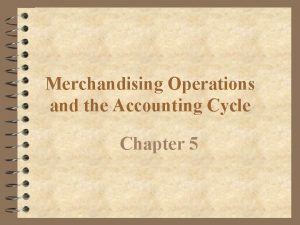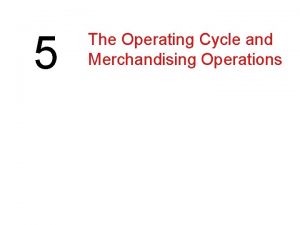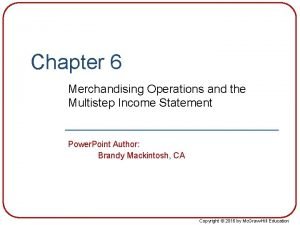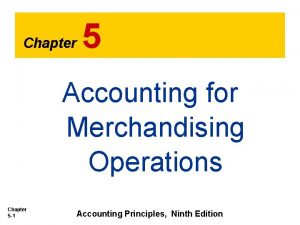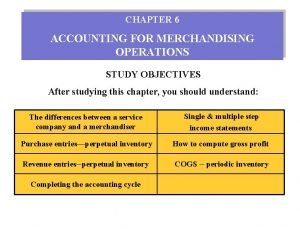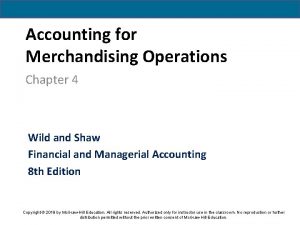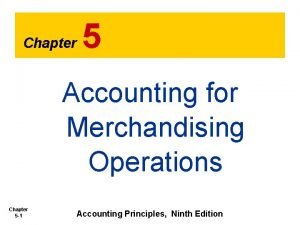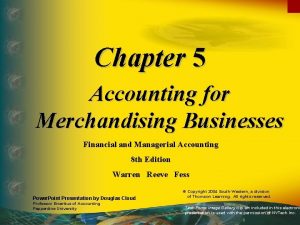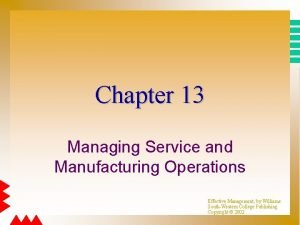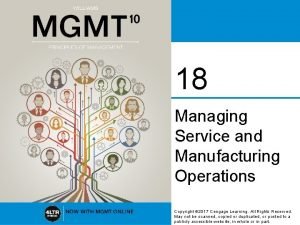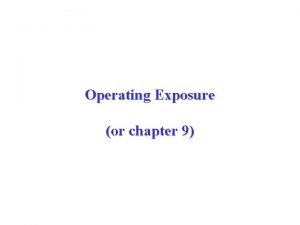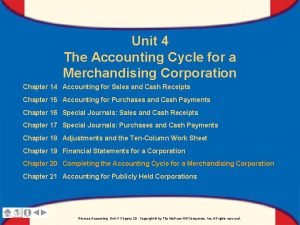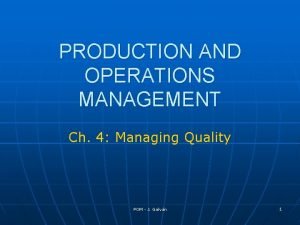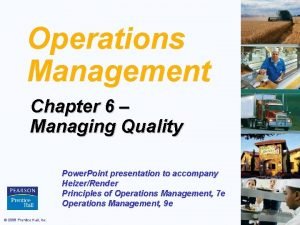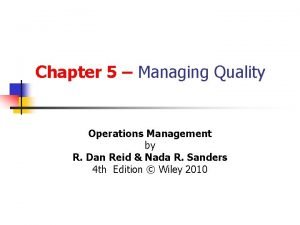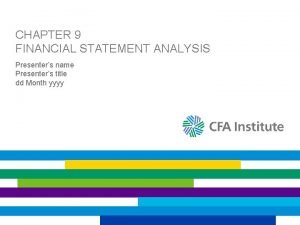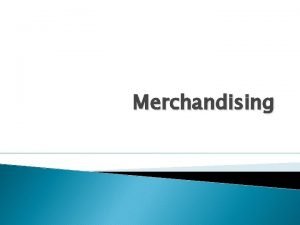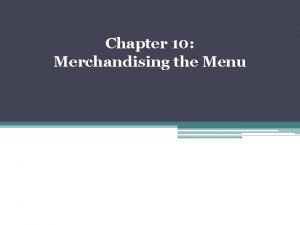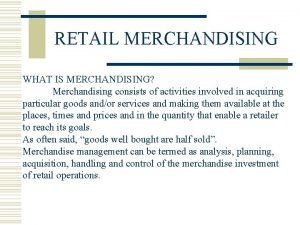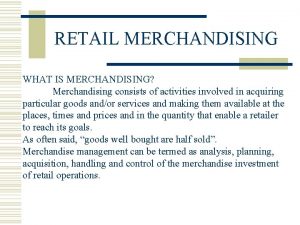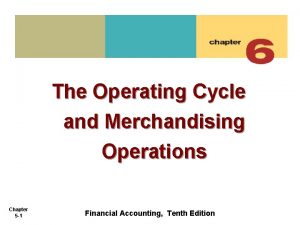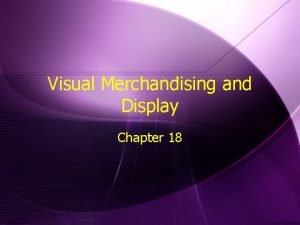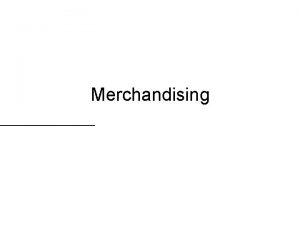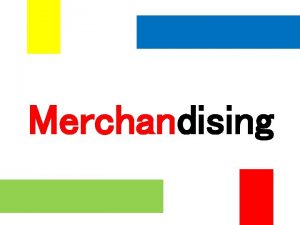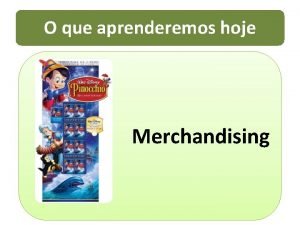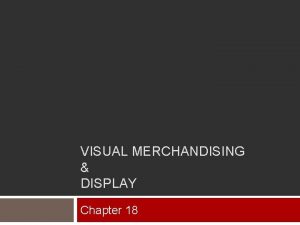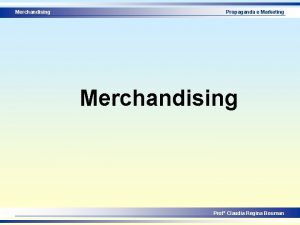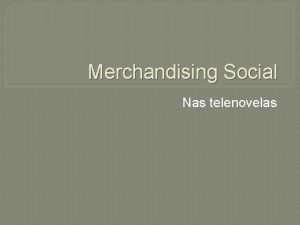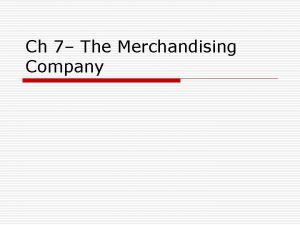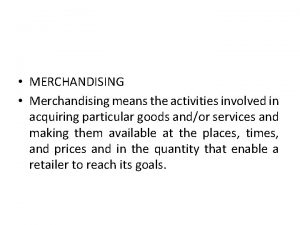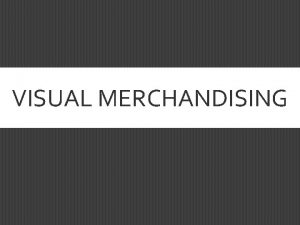5 The Operating Cycle and Merchandising Operations Managing












































- Slides: 44

5 The Operating Cycle and Merchandising Operations

Managing Merchandising Businesses OBJECTIVE 1: Identify the management issues related to merchandising businesses.

Figure 1: Cash Flows in the Operating Cycle

Figure 2: The Financing Period

Managing Merchandising Businesses • A service business provides a service (e. g. , a dry cleaner, an accountant, or a car wash), whereas a merchandising business sells goods (e. g. , a department, drug, or grocery store).

Managing Merchandising Businesses • Operating cycle – Purchase of merchandise inventory for cash or credit – Collection of cash from credit sales – Payment for purchases made on credit – Sales of merchandise inventory for cash or on credit

Managing Merchandising Businesses • Choice of inventory system – Perpetual inventory system • Inventory records are updated with every purchase and every sale. – Periodic inventory system • Inventory records are updated only at the end of the period when a physical count is taken.

Managing Merchandising Businesses • Foreign business transactions – Foreign business transactions involve two currencies. – Timing differences and related changes in the exchange rate may result in exchange gains or losses.

© 2011 Cengage Learning All Rights Reserved. May not be scanned, copied or duplicate, or posted to a publicly accessible website, in whole or in part.

Terms of Sale OBJECTIVE 2: Describe the terms of sale related to merchandising transactions.

Terms of Sale • Trade discounts are reductions from the list price and are not recorded in the accounts. • Sales discounts are offered by the seller for prompt payment. – 2/10, n/30 means that the buyer can take a 2 percent discount by paying within 10 days of the invoice date or paying the full amount within 30 days. – Purchases discounts apply to the buyer.

Terms of Sale • Transportation costs – FOB shipping point means that title to the goods transfers at origin and freight charges are paid by the buyer. – FOB destination means that title to the goods transfers at destination and freight charges are paid by the seller. – Freight-in is the transportation cost paid by the buyer and added to cost of goods sold. – Delivery expense, or freight-out, is the transportation cost paid by the seller and is an operating expense.

Terms of Sale • Terms of debit and credit card sales – Debit cards deduct directly from a person’s bank account, whereas a credit card allows for payment later. – In credit card transactions, the credit card company takes a discount of 2 to 6 percent of the credit card sales, which is taken as a selling expense by the merchandiser.

© 2011 Cengage Learning All Rights Reserved. May not be scanned, copied or duplicate, or posted to a publicly accessible website, in whole or in part.

Perpetual Inventory System OBJECTIVE 3: Prepare an income statement and record merchandising transactions under the perpetual inventory system.

Exhibit 1: Income Statement Under the Perpetual Inventory System

Figure 3: Recording Purchase Transactions Under the Perpetual Inventory System

Figure 4: Recording Sales Transactions Under the Perpetual Inventory System

Perpetual Inventory System • With the perpetual inventory system, inventory records are updated with every purchase and every sale.

Perpetual Inventory System – A purchase of merchandise on credit is debited to the Merchandise Inventory account and credited to the Accounts Payable account.

Perpetual Inventory System – Transportation costs for goods received are debited to the Freight-In account and credited to either the Accounts Payable or Cash accounts.

Perpetual Inventory System • With the perpetual inventory system, inventory records are updated with every purchase and every sale. (cont. ) – A purchase return to the supplier (for credit) is debited to the Accounts Payable account and credited to the Merchandise Inventory account. – A payment on account is debited to the Accounts Payable account and credited to the Cash account.

Perpetual Inventory System – A payment on account is debited to the Accounts Payable account and credited to the Cash account.

Perpetual Inventory System • With the perpetual inventory system, inventory records are updated with every purchase and every sale. (cont. ) – Returns of merchandise by customers are debited to the Sales Returns and Allowances account (a contrarevenue account) and credited to the Accounts Receivable account. – The Sales Returns and Allowances account is debited instead of the Sales account to provide management with data about dissatisfied customers.

Perpetual Inventory System – Under the perpetual inventory system, a second entry is needed to transfer the cost of the returned goods from the Cost of Goods Sold account to the Merchandise Inventory account.

Perpetual Inventory System • With the perpetual inventory system, inventory records are updated with every purchase and every sale. (cont. ) – Receipts from customers on account are debited to the Cash account and credited to the Accounts Receivable account.

Perpetual Inventory System

© 2011 Cengage Learning All Rights Reserved. May not be scanned, copied or duplicate, or posted to a publicly accessible website, in whole or in part.

Periodic Inventory System OBJECTIVE 4: Prepare an income statement and record merchandising transactions under the periodic inventory system.

Exhibit 2: Income Statement Under the Periodic Inventory System

Figure 5: The Components of Cost of Goods Sold

Figure 6: Recording Purchase Transactions Under the Periodic Inventory System

Figure 7: Recording Sales Transactions Under the Periodic Inventory System

Periodic Inventory System • Merchandising income statement under the periodic system – Shows all the detailed computations of cost of goods sold – under the perpetual system, only the total cost of goods sold is disclosed. – With the periodic inventory system, inventory records are updated only at the end of the period, when a physical count is taken.

Periodic Inventory System • Merchandising income statement under the periodic system (cont. ) – Beginning inventory is the merchandise on hand at the beginning of the period. – Ending inventory is the merchandise on hand at the end of the period. The ending inventory of one period becomes the beginning inventory of the next period.

Periodic Inventory System • Merchandising income statement under the periodic system (cont. ) – Net purchases equals total purchases less purchases returns and allowances and purchases discounts. – Net cost of purchases equals net purchases plus freight-in.

Periodic Inventory System • Merchandising income statement under the periodic system (cont. ) – Cost of goods available for sale is the cost of merchandise available for sale during the period. It equals beginning inventory plus net cost of purchases. – Cost of goods sold is the cost to the merchandiser of the goods sold that period. It equals cost of goods available for sale less ending inventory.

Periodic Inventory System • Purchases of Merchandise – Journalize a purchase of merchandise on account.

Periodic Inventory System • Journalize a return of merchandise purchased.

Periodic Inventory System • Journalize a payment on account.

Periodic Inventory System • Sales of Merchandise – Journalize a sale of merchandise on account.

Periodic Inventory System • Journalize a return of merchandise sold.

Periodic Inventory System • Journalize collection from a customer on account.

© 2011 Cengage Learning All Rights Reserved. May not be scanned, copied or duplicate, or posted to a publicly accessible website, in whole or in part.
 A merchandising business earns through
A merchandising business earns through What is the operating cycle of a merchandising business
What is the operating cycle of a merchandising business Merchandising objectives
Merchandising objectives Merchandising operations
Merchandising operations Accounting for merchandise operations
Accounting for merchandise operations Chapter 5 accounting for merchandising operations pdf
Chapter 5 accounting for merchandising operations pdf Account titles for merchandising business
Account titles for merchandising business Chapter 4 accounting for merchandising operations
Chapter 4 accounting for merchandising operations Merchandising operations
Merchandising operations Chapter 5 accounting for merchandising operations solutions
Chapter 5 accounting for merchandising operations solutions Fob shipping point accounting
Fob shipping point accounting Measuring and managing operating exposure
Measuring and managing operating exposure Exposure
Exposure Food and beverage cycle
Food and beverage cycle Managing service and manufacturing operations
Managing service and manufacturing operations Managing service and manufacturing operations
Managing service and manufacturing operations What is the objective of managing operating exposure?
What is the objective of managing operating exposure? Operating exposure
Operating exposure Post closing trial balance merchandising
Post closing trial balance merchandising Managing quality in operations management
Managing quality in operations management Chapter 6 managing quality
Chapter 6 managing quality Managing quality in operations management
Managing quality in operations management Managing front office operations 10th edition
Managing front office operations 10th edition Working capital management refers to
Working capital management refers to Zero working capital
Zero working capital Operating cycle formula
Operating cycle formula Return on average assets
Return on average assets Operating cycle formula
Operating cycle formula Hình ảnh bộ gõ cơ thể búng tay
Hình ảnh bộ gõ cơ thể búng tay Frameset trong html5
Frameset trong html5 Bổ thể
Bổ thể Tỉ lệ cơ thể trẻ em
Tỉ lệ cơ thể trẻ em Voi kéo gỗ như thế nào
Voi kéo gỗ như thế nào Tư thế worms-breton
Tư thế worms-breton Chúa yêu trần thế
Chúa yêu trần thế Các môn thể thao bắt đầu bằng tiếng đua
Các môn thể thao bắt đầu bằng tiếng đua Thế nào là hệ số cao nhất
Thế nào là hệ số cao nhất Các châu lục và đại dương trên thế giới
Các châu lục và đại dương trên thế giới Công thức tính thế năng
Công thức tính thế năng Trời xanh đây là của chúng ta thể thơ
Trời xanh đây là của chúng ta thể thơ Cách giải mật thư tọa độ
Cách giải mật thư tọa độ Phép trừ bù
Phép trừ bù Phản ứng thế ankan
Phản ứng thế ankan Các châu lục và đại dương trên thế giới
Các châu lục và đại dương trên thế giới Thể thơ truyền thống
Thể thơ truyền thống
